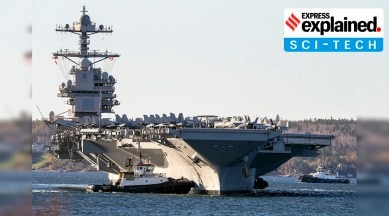USS Gerald R Ford deployed to assist Israel: 5 things to know about the $18 billion aircraft carrier
Just how big is the carrier? How fast can it go? What are its capabilities? What does the carrier strike group comprise? Who is it named after?

After a surprise attack on Israel by Hamas Saturday (October 7) escalated the decades long conflict in the region, US Defence Secretary Lloyd Austin on Sunday ordered the USS Gerald R Ford carrier strike group to sail to the Eastern Mediterranean to assist Israel, if the need arose.
The deployment reflects the United States’ steadfast support of Israel, and its desire to deter any further regional expansion of the conflict. “The US maintains ready forces globally to further reinforce this deterrence posture if required,” Austin said in a statement.
Here are 5 things that you should know about the USS Gerald R Ford.
1. Gargantuan size
The USS Gerald R Ford is the largest warship ever built. It is 337 m long, 78 m wide (measured at the flight deck) and 76 m high. For perspective, the Qutub Minar in Delhi is just 72 m high — more than 4.5 Qutub Minars would fit on the deck of the USS Gerald R Ford, lengthwise. It also displaces 100,000 tonnes at full load — equivalent to nearly four times the weight of steel used for the Howrah Bridge.
For comparison, India’s aircraft carrier INS Vikrant weighs 45,000 tons at full load, with dimensions of 262 m x 62m x 59m.
2. Carries up to 90 aircraft, more than 4,500 personnel
The carrier’s size allows it to support up to 90 aircraft, including the fifth gen F-35, F/A-18 Super Hornet, E-2D Advanced Hawkeye, EA-18G Growler electronic attack aircraft, MH-60R/S helicopters, as well as a number of UAVs. To conduct all operations aboard the carrier, a crew of over 4,500 personnel is needed (including those running the ship, those in the air wing and other support staff).
For comparison, INS Vikrant operates a total of 36 aircraft and is run by a crew of roughly 1,650.
3. Very agile for its size
Despite its size, the aircraft carrier is remarkably agile. With a top speed of over 30 knots (56 kmph), the Ford class carrier can keep up with much smaller vessels.
This is due to the power generated by its two A1B nuclear reactors, offering 250% more electrical capacity than the Nimitz Class (the US’s previous generation of carriers). These reactors have a life cycle of ≈ 25 years.
4. Always travels in a carrier strike group
Aircraft carriers are offensive weapons and mightily expensive symbols of a nation’s military might. This means that despite its aircraft and onboard defence systems, the Gerald R Ford, like all aircraft carriers, always travels with the defensive cover of a carrier strike group (CSG).
A standard US CSG comprises a cruiser, at least two frigates or destroyers, and a supply ship. On occasion, a CSG may also boast of one or more submarines. The US has sent cruiser USS Normandy and destroyers USS Thomas Hudner, USS Ramage, USS Carney, and USS Roosevelt, along with the Gerald R Ford to the Eastern Mediterranean.
5. Named after former President Gerald R Ford
The aircraft carrier, which entered service in 2017, is named after former US President Gerald R Ford (in office: 1974-77). Ford (1913-2006) served in the US Navy during World War II, enlisting after the Pearl Harbour Attack (December 7, 1941). Ford served as an assistant navigator, Athletic Officer, and anti aircraft battery officer on board the aircraft carrier USS Monterey, and saw action in the Pacific Theatre.
On January 3, 2007, then Secretary of Defense Donald Rumsfeld announced during a eulogy to the recently deceased Ford that the latest aircraft carrier under development would be named after him.
For the latest coverage on the ongoing conflict in Gaza and much more, visit the Explained Page.